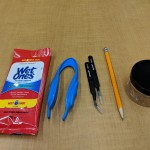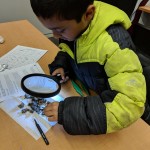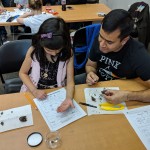In our most recent family science program, we featured owl pellet dissection. This allowed for hands on science exploration for youth in grades K-5 with a grownup using tools and resources to mimic scientists in the field. Here’s what we did.
We ordered barn owl pellets from a science supplies distributor via Amazon. We learned that barn owl populations are on a decline so we limited our program to use 12 pellets, for a total of 12 children plus their adult caregiver. From previous programs, we had jumbo plastic tweezers as well as metal tweezers on hand. And we purchased small plastic specimen jars for science programming throughout the spring. Each table was provided with Wet Wipes, paper towels, and pencils.
For the program, we printed copies of Carolina Biological Supply Company’s bone chart as well as an owl pellet fact sheet. Each youth participant received copies of these handouts to use throughout the dissection. Additionally, we provided large magnifying glasses with LED lights to take a closer look at what we found in the pellets. Aside from the pellets and plastic jars, all other supplies are reusable in other capacities.
At the beginning of the program, we started with a group discussion about what we knew collectively about owls, including their diets. We asked participants to define carnivore, herbivore, and omnivore, and then asked which category owls belonged to. Participants shared what they believed owls ate and we then compared owl digestion to human digestion before watching a short video of a female barn owl regurgitating an owl pellet. (There was a disclaimer before showing the video but the participants overwhelmingly enjoyed viewing it so we watched it twice.)
After viewing the video, we explained that each youth participant would receive an owl pellet to dissect. As a group, we shared predictions about what we might find in the pellets. Then staff provided clear instructions on how to use the tweezers safely and stressed that since we would be handling animal products, participants were asked to wipe their hands with Wet Wipes before leaving and then immediately wash their hands with soap and water in the washrooms outside the program room. Then we passed out the pellets and remaining supplies and watched as participants got to work.
It was great to see adult caregivers asking guiding questions while encouraging their children to do most of the dissection. No child had issues touching the owl pellet materials but we did provide the larger plastic tweezers and had plastic gloves available in case there were aversions. As participants dissected, staff walked around and asked what bone fragments they found and if they identified the type of prey animal the bones came from.
Since participants worked at their own pace, staff facilitators regrouped after 30 minutes of dissection to allow youth participants to share their findings and compare their results with others. The entire program lasted an hour and only a handful of families used the entire time.
We heard from participants that only a handful of schools in the community include owl pellet dissection as part of the curriculum so they appreciated the opportunity to do so in the library. Because of this feedback, we’re looking at offering a repeat program assuming we’ll be able to purchase pellets.







How cool, Amy! Would you believe that I had a group do owl pellet dissection just two weeks ago? I did it as part of my Science Action Club. I’ll be writing about it in my next blog.
That’s great, Luna! I hope you had a positive experience as well and look forward to reading about it.